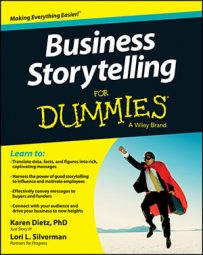What you do. What I do. What we do. All are important business stories to have in your hip pocket for those moments when you’re asked about them.
Stories about what you do
What you do stories are memorable moments in your work life that define how you spend your time. Telling stories about that isn’t as easy as it may seem. Why? Because many people tend to describe what they do — they don’t tell stories that allow others to experience what they do as an individual.
Here’s an example. When asked what kind of work she does as a consultant, Lori could easily say, “I’m a strategist.” Followed by, “I help organizations develop long-range breakthrough-oriented scenario-based strategic plans and implement large, messy changes.” But how boring. And what a mouthful of words. Instead she often relates this story:
One of the exciting parts of my work is I get to meet and talk with business leaders in a whole variety of industries. One day, I was to interview a board president to gain some insights so I could facilitate scenario development with the entire board and the organization’s most senior leaders.
Before I could ask him the questions I’d prepared, he said, “There are a few things I’d like to ask you first. I’m interested in knowing exactly what you do and how you got here.” I replied, “Do you want to know the actual situation or might I provide another response?” He answered, “I’d like to hear both.”
I said, “My client contact attended a workshop I gave three weeks ago on strategic thinking. She left mid-afternoon to meet with her CEO. An hour later, while I was still teaching, she called, texted, and e-mailed to say her CEO wanted my help with this board retreat.
Several of us spoke by phone about how to best use the morning of the retreat in light of the organization’s desire to create a new strategic plan. Based on what I learned in that call, I suggested we do scenario planning. That’s how I got here.”
“Now, for what I really do. I’d like you to meet Mary Poppins. A need appeared and I showed up. I’m just beginning to learn about the organization and how to approach the retreat.” He laughed, and we proceeded with the interview.
At the end of the meeting, before we departed, he said, “I have one thing to ask of you. I’d like you to consider folding up your umbrella and staying awhile, Mary Poppins.”
Like Mary Poppins, I often get asked to show up, without much notice, and without a lot of fanfare. When I sense my work is done, which means the organization has gotten what it needs and is able to proceed on its own, I fold up my umbrella and go elsewhere.
Do you see how this story allows you to experience what Lori does as a consultant? Not only does it offer an example of what she does, it also employs the Mary Poppins metaphor which adds another dimension to the conversation. She excels at meeting last-minute demands.
Here’s how you can identify stories so others can experience what you do:
Tell me about a time when you were influenced by a mentor or coach and how that shaped the way you view your work.
Paint me a picture of a memorable moment in your career that’ has impacted your perception of the work that you do.
Enlighten me about an event that’ has profoundly impacted you as a person and how this is reflected in your work.
Tell me about the personal legacy that you’re leaving through the work that you do.
Tell me a story about your work that reflects its ultimate importance.
Stories about what the enterprise does
In his 2009 TEDx talk, "Start With Why", advertising professional Simon Sinek says sharing what you do falls into three circles:
The outermost circle: This is the what — what you do.
The middle circle: This is the how — how you do it.
The innermost circle: This is the why — why you do what you do.
He finds that few businesses know this. Instead, they reveal what they do by talking about the what. You’ll hear something like: “We make great phones. They’re easy to use and simply designed. Want to buy one?”
The why of what your enterprise does isn’t to make a profit. That’s the result. The why is what it believes in. People want to do business with organizations that believe in what they do. It all starts with having a passion for something: to change the world in some way, to expand horizons, make people safe, enlighten, serve, entertain, bring comfort or joy — or solve a problem.
Here’s how one organization connects in this manner through story. Since 1979, Mercy Corps has been “helping people in the world’s toughest places survive crises they confront and turn them into opportunities to thrive.” When you visit the nonprofit’s home page, you’ll see a link to Top Stories.
These stories are authored by field staff, in narrative form or as photo essays. They’re first-hand accounts of what they learn when assisting individuals, families, and entire communities.
What can your organization do to have publically visible stories in its hip pocket likes Mercy Corps? Try the following:
Tell a story about the why behind what you, as staff, are collectively paid to do as an organization.
Talk about a customer challenge that demonstrates what drives your business.
Enlighten someone about a situation that demonstrates the impact your organization has on the lives of individuals or the community at large.
Visualize and tell me about a specific moment in time that revealed to you and your colleagues the importance of the work you all do.

